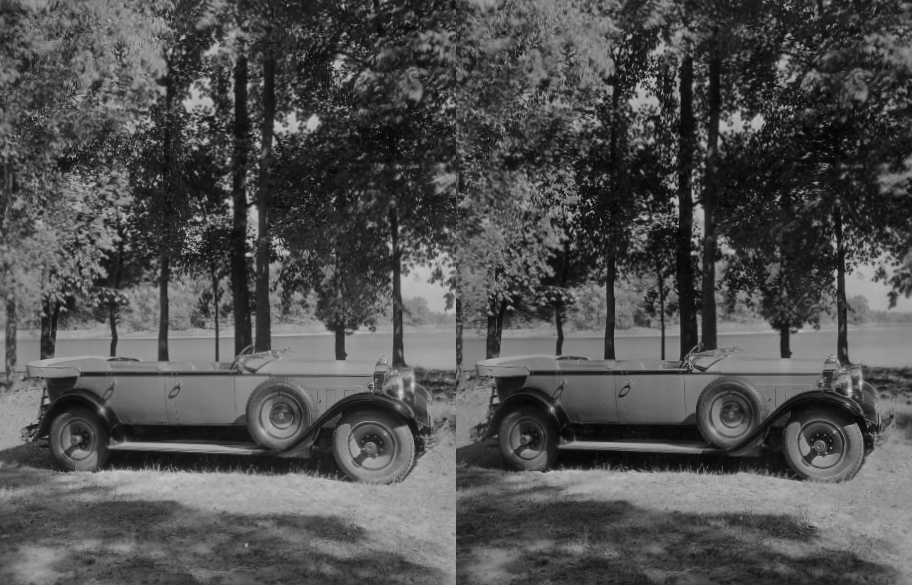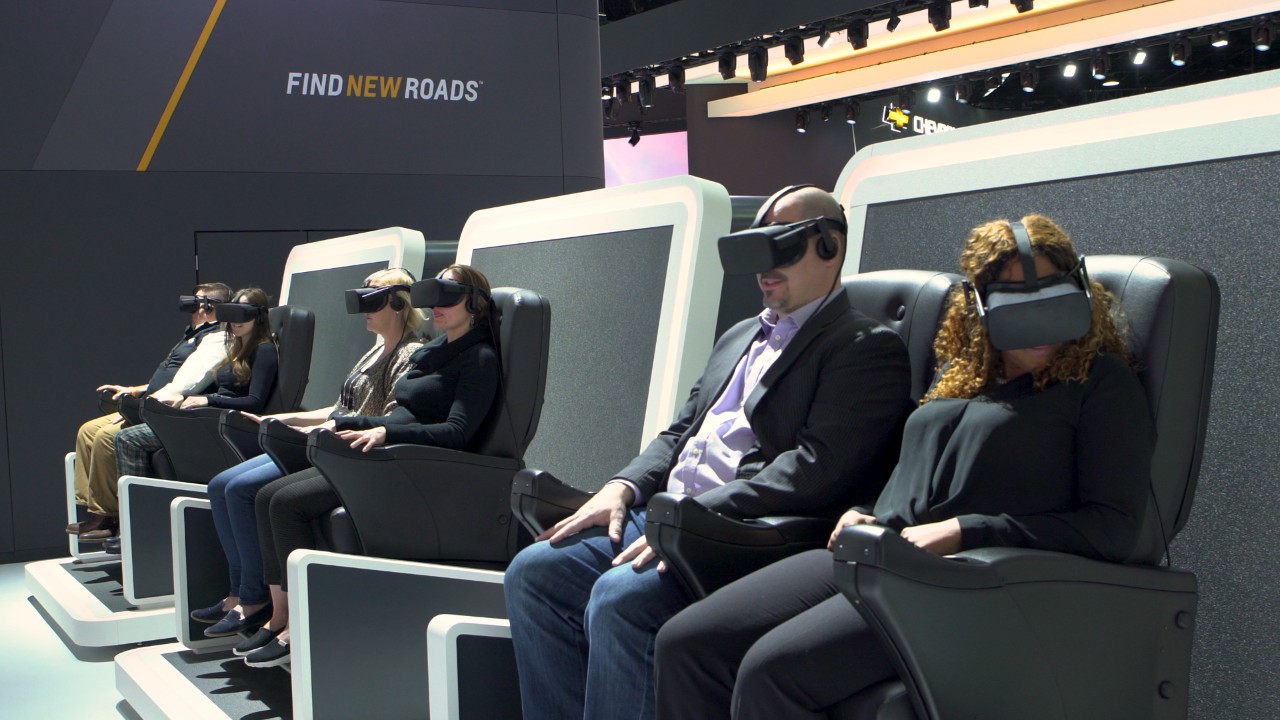Virtual reality in the automotive world: then and now
You’ve probably noticed that many automakers’ auto show exhibits now include some kind of virtual reality experience. In the past two or three years, brands including Porsche, Chevrolet, Nissan, Kia, Ford, Volvo, and Acura have included VR in their displays, ranging from single-seat racing simulators at Acura to large scale multi-viewer setups complete with motion simulators at Ford.


Manufacturers may be putting VR to use for the first time in design and engineering, but you may be surprised to know VR’s not that new in the auto industry.
Those VR setups only hint at how much the auto industry uses stereographic and virtual reality display technologies. You might think that the most sophisticated use of high-tech graphics rendering, like virtual reality and 3D, is in the entertainment and gaming industries. In reality, it’s the people who design and make real physical objects who make the most of 3D and VR tech, rather than those who bring imaginary plots and characters to virtual reality.
The automobile industry, in particular, uses advanced stereo and VR imaging in a variety of ways throughout design, engineering, testing, and marketing. If a character in an animated movie or video game isn’t exactly perfect, it probably won’t matter in real life. If a car’s components don’t mate with other parts on the assembly line or if it can’t be serviced by human beings with normal limbs and joints, that’s a problem.
For example, Ford’s immersive vehicle environment (FIVE) in the virtual reality lab at the automaker’s Product Development Center in Dearborn, Michigan, uses both VR goggles and highly-sensitive motion detectors to put engineers, designers, and researchers into virtual cars and trucks before physical prototypes are even made. In the virtual reality lab interfaces, packaging, ergonomics, and aesthetics can be checked before expensive investments in final tooling are made. Also, the displays can give the goggle wearers wire-frame, cutaway, and even x-ray views of individual components or completed vehicles. Because the environment is virtual and digital, teams around the world can simultaneously work in the same virtual environment, thus speeding development.
It’s not really surprising that today’s auto industry has embraced VR in both making and selling cars. Automakers have been using advanced imaging tech to market their cars for nearly a century. First, though, a little history.
The making of 3D photographs, also known as stereographs or stereograms, started not long after photography itself was developed and as soon as two camera shutters could be synchronized. Matthew Brady took 3D photos of President Abraham Lincoln during the Civil War, about the same time that U.S. Supreme Court Justice Oliver Wendell Holmes invented an improved stereoscope for viewing stereo photographs. A stereoscope uses prismatic lenses to direct each image to the appropriate eye. In normal stereo vision, the brain creates a 3D image of the world from the two “flat” images presented to it by each eye. Recreating a 3D view with photographs or other images involves giving each eye a parallax view of the target. The brain does the rest.
Note: The stereo images displayed in this post are in “cross-eye” format. Viewing instructions here.
Even though we wake up every morning and see a three-dimensional world from the middle of a 360-degree sphere without any special equipment, people today are amazed with 3D and VR displays. People in the 19th century were similarly fascinated with 3D photography.
In the years before folks could be entertained with radio or television, they amused themselves by viewing stereographs. A number of companies sprung up to supply that market, with teams of photographers literally traversing the globe so viewers could experience wonders of the world like the pyramids of Egypt or the Taj Mahal virtually in three dimensions. The largest of those companies was the Keystone View Company, based in Pennsylvania. From 1892 to 1963, Keystone produced millions of stereo photographs, many of them now in the archives of the photography department at the University of California, Riverside.


In that archive is a set of stereographs taken in 1927 of a number of Packard automobiles in Detroit and in the Irish Hills about 90 miles west of the Motor City. Because of the wide variety of Packard models featured in the 3D photos, the images were likely produced with the cooperation of Packard Motor Cars. Perhaps not coincidentally, Keystone also used a Packard as a camera car.

The first public viewing of a 3D movie in the United States took place 12 years later, at the 1939 New York World’s Fair, in Chrysler’s exhibit. The automaker had commissioned filmmaker John Norling to make In Tune With Tomorrow, a stop-action, black-and-white animated short showing a Plymouth being assembled. Working with Jacob Leventhal, Norling had developed a 3D motion picture rig using Bell & Howell cameras and angled mirrors. Edwin Land, who would later develop instant photography, had started the Polaroid company to make polarized light filters. Using two projectors, polarized filters, and polarized eyeglasses, Land came up with a projection system not that much different than the 3D systems used in modern movie theaters and 3D television sets.
One and a half million people paid 25 cents for a cardboard and acetate 3D viewer in the shape of a ’39 Plymouth so they could see In Tune With Tomorrow. The 3D movie was so popular that for the 1940 run of the World’s Fair Chrysler had Norling reshoot the film in Technicolor, retitling it New Dimensions.
In the late 1940s, the introduction of the Stereo Realist 35mm stereo camera and an associated battery powered 3D viewer sparked a huge 3D craze that eventually resulted in Hollywood’s embrace of 3D with films like “The Creature From the Black Lagoon” being produced in stereo for the first time. That fad resulted in “New Dimensions” getting a theatrical release under the title “Motor Rhythms.”
Coincidentally, the 3D craze of the late 1940s and early 1950s also resulted in the creation of the Nash Healey sports car. While on a trans-Atlantic crossing in hopes of getting Cadillac to sell him some of their then-new high-compression V-8 engines to install in his British sports cars, Donald Healey spotted a very large man using a stereo camera up on the deck. Healey was a photography buff, so he struck up a conversation with the man, who turned out to be George Mason, the head of the Nash car company.
Healey told Mason of his plans concerning Cadillac and Mason informed him that he wasn’t likely to strike a deal with Cadillac since the manufacturer was already selling all the V-8-powered Cadillac cars they could build. But if things didn’t work out in Detroit, Mason added, Healey should ring him up in Kenosha. That’s how Healey ended up getting Nash engines, transmissions, and rear ends with favorable financing, in addition to the dealer network he needed to sell the cars.
It’s not clear if Mason’s interest in stereo photography is related, but in the early 1950s, Nash released a Nash-branded Sawyer ViewMaster 3D viewer to its dealers, along with custom ViewMaster reels with 3D images of Nashes and Ramblers. After Nash and Hudson merged, Hudson also got involved with 3D.
If one of the independents was going to use a ViewMaster, General Motors had an image to uphold. GM went with the premium Stereo Realist “red button” 3D viewer for watching glass slides created in the Stereo Realist format. For 1951, GM had sets produced for both Cadillac and Oldsmobile dealers, in custom vinyl-covered boxes for the viewers and slides. The slides featured exterior and interior shots of all of those brands’ cars.



The first true postwar Oldsmobiles, introduced as 1949 models, carried the Futuramic brand and were not much like the 1930s-styled prewar cars at all. The Olds Stereo Realist sets are labeled “Futuramic Oldsmobile Three Dimension Theater,” with the image of a rocket flying across the cover, symbolic of the “Rocket” V-8, also introduced with the ’49 model year.
Photos: futuramic oldsmobile three dimension theater [1-4]
Oldsmobile also had a set of slides produced illustrating its new V-8 engine being assembled in Lansing, Michigan. Cadillac released additional slide sets in 1955 and 1959.
In the early 1980s, Oldsmobile returned to 3D with some ViewMaster reels, and in 2003, General Motors released a GM-branded ViewMaster with a 3D reel featuring all of the automaker’s brands and promoted the giveaway with network television ads. There is also an undated Hummer H1 reel in circulation. According to this database of commercial ViewMaster reels, GM’s Opel, Vauxhall, and Bedford truck units in the UK and Europe also released 3D reels. Ford used ViewMaster 3D reels to promote the 2005 Freestyle crossover.


The Olds and Cadillac slide sets and viewers come up on auction sites like eBay from time to time. Between $300 and $500, depending on condition and number of surviving slides, they’re a unique way to spiff up the trunk of your 1950s Oldsmobile or Cadillac on display at a car show.
The more things change, the more they stay the same. Perhaps 60 years from now, folks displaying Fords, Audis, and Jaguars at car shows will have a period-correct Vive or Oculus VR headset in the trunk.










